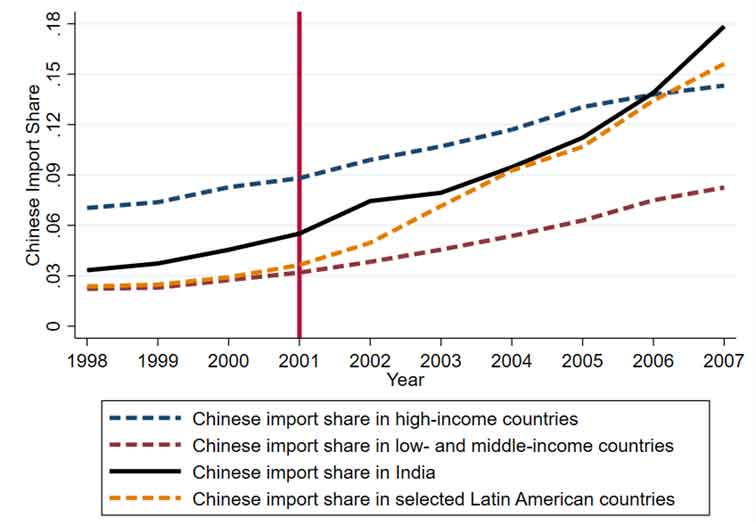Given the recent expansion in the participation of developing countries in global trade, it is important to understand the role of trade in the allocation of employment across the formal and informal sectors in these countries. Analysing the case of Indian manufacturing and Chinese imports, this article shows that import competition leads to an increase in the share of formal-sector employment – driven by greater usage of contract workers in the formal sector – and higher aggregate labour productivity.
A large informal sector could hinder economic growth, for reasons such as low productivity, and low fiscal capacity on account of poor tax collection. Thus, a reallocation of resources from the informal to the formal sector can increase aggregate productivity in the economy and thereby enable growth and development. Not surprisingly, the formalisation of the economy is a top policy goal in several developing countries, and various options have been considered in this regard, such as lowering of registration costs for formal-sector firms, providing capital grants to enable small firms to grow, and dismantling policies based on firm size.1 At the same time, given the recent expansion in the participation of developing countries in global trade, it is important to understand the role of trade in the allocation of employment across formal and informal sectors in these countries.
In recent research (Chakraborty, Singh and Soundararajan 2020), we examine the impact of competition that domestic production faces from imports, on the allocation of workers between the formal- and informal-sector firms in Indian manufacturing. Note that our definition of formalisation/informality is firm-based, following Nataraj (2011) and McCaig and Pavcnik (2019). In this sense, by formalisation, we refer to the reallocation of employment from informal-sector firms to formal-sector firms.
The existing evidence on the effect of import competition on informality in developing countries is mixed. This is not surprising because multiple pathways govern the relationship between import competition and informal-formal sectoral composition of employment. On the one hand, imports may spur domestic producers of the same goods to cut costs by moving activities and resources to the informal sector, for example, through outsourcing. This channel increases informality. On the other hand, if domestic, informal firms are adversely affected by import competition because they are unable to complete, the informal sector shrinks, and resources get reallocated to the formal sector. This channel increases formalisation. The empirical literature mostly finds null effects (Goldberg and Pavcnik 2003), with a few studies pointing to increased informality (Dix-Carneiro and Kovak 2019) in response to an increase in import competition.
Studying the effects of import competition: Two challenges
Two challenges arise when we study the effects of import competition on the formalisation of workforce.
First, while comprehensive data on formal-sector firms and employment is available, similar informal-sector data are often unavailable. To the best of our knowledge, India is the only country that undertakes regular, comprehensive surveys of informal sector firms that cover rural and urban areas and use firms as the sampling units. We utilise data from the National Sample Survey (NSS) Unorganised Enterprise Survey, combined with formal sector, firm-level data from the Annual Survey of Industries (ASI) for the years 2000-2001 and 2005-2006, to study the allocation of employment between the formal and informal sectors.
Second, imports in a particular industry may be driven by changes in domestic demand or technology shocks that may simultaneously affect employment and employment allocation. For example, if a new technology in India results in a higher need for labour and also increases the demand for imports into India, then the measured impact of the effect of imports on employment will not be causal as this is essentially driven by technology changes. To circumvent any ‘endogeneity’2 concerns arising from this, we focus on imports from China. Chinese imports are plausibly ‘exogenous’ to our analysis, as these are driven by China's own productivity enhancement measures – such as the establishment of Special Economic Zones and technology transfers through foreign direct investments – and are not driven by India’s demand for Chinese imports (Autor et al. 2013).
To address remaining endogeneity concerns, we ‘instrument’3 for Chinese imports to India with Chinese imports to a set of Latin American countries, to isolate the variation in Chinese imports to India that are only driven by supply-side factors in China. The choice of Latin American countries was motivated by the fact that they are not major trade partners with India and hence, are unlikely to have a direct influence on informality in India.
The relevance of China
Figure 1 below shows that the rise in manufacturing imports from China is universally observed in India, as well as across different country groups. Chinese imports to India grew faster than Chinese imports to other countries. In 2007, the value of Chinese imports constituted a whopping 18% of all imports in India. Thus, the focus on Chinese imports is crucial, beyond their role in our analysis of providing ‘exogenous variation’, as discussed above.
Figure 1. Chinese import shares, 1998-2007

Note: Chinese import share to a particular country/group of countries is the share of imports from China in that country/group of countries in all imports in that country/group of countries.
Source: UN-COMTRADE (United Nations Commodity Trade Statistics Database).
Import competition increases formal sector employment share
Our primary finding is that competition to domestic production from Chinese imports, leads to an increase in the share of formal-sector employment in total employment in India. Between 2000-01 and 2005-06, Chinese import competition increased the formal share of employment in India by 3.9 percentage points. This increase is driven both by an increase in employment in the formal sector (driven by firms with high productivity), and a decrease in employment in the informal sector, suggesting a reallocation of employment from the informal to the formal firms.
So far, there is evidence of the positive effects of trade liberalisation on formalisation only via the channel of countries obtaining access to export destinations (McCaig and Pavcnik 2018). The extent to which imports could lead to a reallocation of workers towards the formal sector, thereby increasing productivity overall, is hitherto unestablished. Hence, these results are novel. We ascribe the findings to the unique case of Chinese imports directly competing with the micro, small, and medium manufacturing firms in the informal sector, of which there is considerable anecdotal evidence (Khan 2014).
We also find evidence of net losses in state-industry level manufacturing employment overall, driven by a large decline in informal-sector employment. In ongoing work, we seek to estimate the effects on employment at the local economy (district) level to account for possible assimilation of informal manufacturing workers into other sectors of the economy, such as services and agriculture. This will enable us to capture the overall effect of Chinese imports on employment.
Role of contract workers
We also show that the hiring of contract workers4 dominates the observed increase in employment by formal firms. That is, the reallocation of workers from the informal s to formal firms is enabled through the institution of contract workers. Furthermore, the rise in formalisation led by contract workers is predominantly observed in states that have stricter employment protection laws (Industrial Disputes Act, 1956) for regular workers (pro-worker states as per Besley and Burgess 2004), and states with high unionisation rates (states with an above-median unionisation index from Dougherty 2009). This is not surprising because unlike the directly hired regular workers, contract workers do not carry firing costs imposed by employment protection legislations and are often not associated with firm-level unions.
Aggregate productivity gains
We calculate aggregate gains in labour productivity due to the shift of workers from the informal to formal sector in response to increased Chinese import competition.5 We measure labour productivity as revenue per worker. Adjusting for differences in firm characteristics such as human capital, months in operation, and output elasticity,6 we find that the labour productivity gap between the two sectors is 3.84. This gap implies that in response to Chinese import competition between 2000-01 and 2005-06, there was an increase in aggregate labour productivity of 3.3%. The reallocation also leads to a gain in annual wages of about 1.5% for the reallocated workers. In ongoing work, we intend to further correct for differences in labour productivity due to sectoral differences in mark-ups by comparing physical production per worker across the two sectors.
Discussion
Our findings underscore the importance of the rise in Chinese exports in the last few decades, for aggregate efficiency in other developing countries. The increase in aggregate efficiency due to reallocation from the informal to the formal sector, however, comes with a decline in manufacturing employment overall in the short term (that is, a span of five years). Understanding the medium- to long-term consequences for employment in response to Chinese import competition in developing countries is an important topic for future research.
I4I is now on Telegram. Please click here (@Ideas4India) to subscribe to our channel for quick updates on our content
Notes:
- In India, for instance, for decades, a list of ‘reserved’ products were to be produced only in small-scale industries. Starting 1997, these products slowly began to be de-reserved.
- An endogeneity problem occurs when the outcome of interest and the explanatory factor are determined simultaneously, or when both are correlated with another factor that is not a part of the analysis – making it difficult to establish that the explanatory factor causes the outcome.
- Instrumental variables are used in empirical analysis to address endogeneity concerns. An instrument is an additional factor that allows us to see the true causal relationship between the explanatory factor and the outcome of interest. It is correlated with the explanatory factor but does not directly affect the outcome of interest.
- Contract workers are those hired by formal firms using third-party intermediaries, and are covered by the Contract Labour Act, 1970.
- These are calculated based on the standard assumption in the development accounting framework (Caselli 2005), that the ratio of marginal product of labour equals the ratio of average product of labour across the two sectors.
- Output elasticity is the percentage change in output (production of a single firm) as a result of 1 percentage change in an input.
Further Reading
- Autor, David H, David Dorn and Gordon H Hanson (2013), “The China syndrome: Local labor market effects of import competition in the United States”, American Economic Review, 103(6): 2121-2168.
- Besley, Timothy and Robin Burgess (2004), “Can labor regulation hinder economic performance? Evidence from India”. The Quarterly journal of economics, 119(1): 91-134.
- Caselli, F (2005), ‘Accounting for cross-country income differences’, in P Aghion and S Durlauf (eds.), Handbook of Economic Growth.
- Chakraborty, P and R Singh and V Soundararajan (2020), ‘Import Competition, Formalization, and the Role of Contract Labor’, IIM Bangalore Research Paper No. 633.
- Dix-Carneiro, Rafael and Brian K Kovak (2019). “Margins of labor market adjustment to trade”, Journal of International Economics, 117: 125-142.
- Dougherty, Sean M (2009), “Labour regulation and employment dynamics at the state level in India”, Review of Market Integration, 1(3): 295–337.
- Goldberg, Pinelopi Koujianou and Nina Pavcnik (2003), “The response of the informal sector to trade liberalization”, Journal of Development Economics, 72(2): 463-496.
- Khan, T (2014), ‘Drag on the Rampage’, Business Line, 2 March.
- McCaig, Brian and Nina Pavcnik (2018), “Export markets and labor allocation in a low-income country”, American Economic Review, 108(7): 1899–1941.
- McKenzie, D (2017), “Identifying and spurring high-growth entrepreneurship: Experimental evidence from a business plan competition”, American Economic Review, 107(8): 2278–2307
- Nataraj, Shanthi (2011), “The impact of trade liberalization on productivity: Evidence from India’s formal and informal manufacturing sectors”, Journal of International Economics, 85(2): 292–301.
- Rocha, Rudi, Gabriel Ulyssea and Laisa Rachter (2018), "Do lower taxes reduce informality? Evidence from Brazil", Journal of Development Economics, 134 : 28 – 49




 27 January, 2021
27 January, 2021 






Comments will be held for moderation. Your contact information will not be made public.